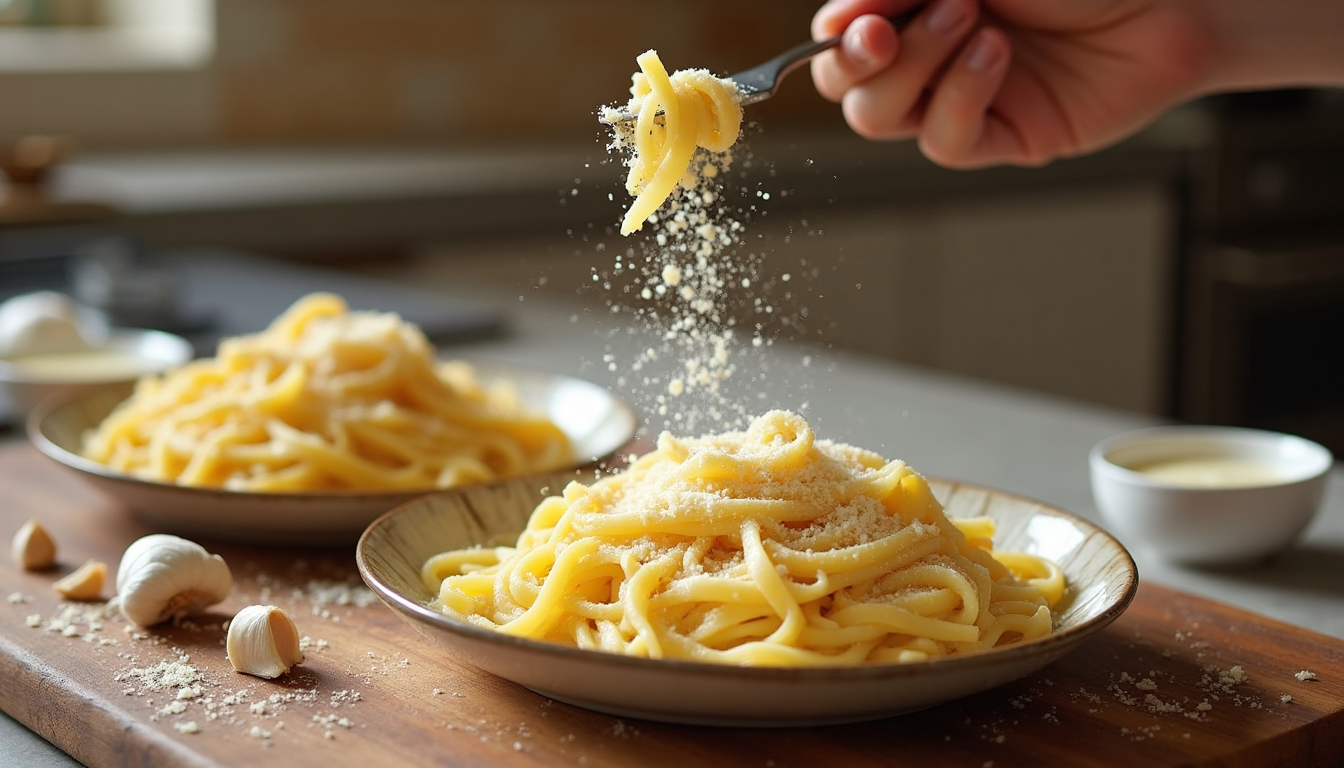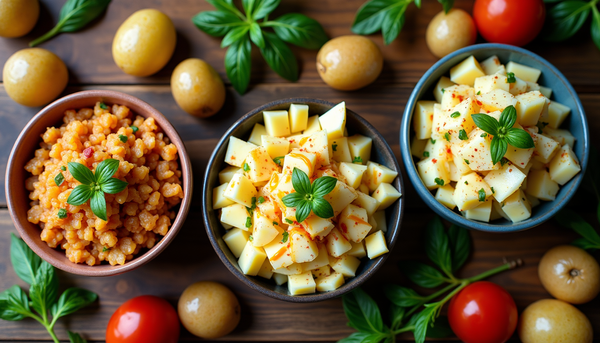The Alfredo Wars: Why Perfect Isn't the Point

The Alfredo Wars: Why Perfect Isn't the Point
There's this moment—you know the one—when you're standing in your kitchen at 6 PM, staring into the fridge, and all you want is something that feels like a warm hug on a plate. For me, that something is almost always fettuccine alfredo.
But here's where it gets interesting (and a little controversial, if I'm being honest). I've been making this dish for fifteen years, ever since my college roommate taught me her mom's "secret" recipe, and I've discovered something that might ruffle some feathers in the food world: the whole authenticity debate around alfredo is kinda... missing the point?
The Great Alfredo Divide
Look, I get it. Food purists will tell you that "real" alfredo—the kind served at Alfredo alla Scrofa in Rome—is just butter, Parmigiano-Reggiano, and pasta water. Simple. Elegant. Perfect.
And you know what? They're absolutely right. I had the privilege of trying it in Rome three years ago (yes, I'm that person who seeks out "the original" everything when traveling), and it was transcendent. The cheese melted into liquid gold, the pasta was perfectly al dente, and every bite was... well, it was poetry.
But here's my hot take: the creamy, garlicky, slightly thick American version isn't some bastardized knockoff that we should apologize for. It's its own beautiful thing. When my eight-year-old nephew requests "that pasta with the white sauce" for his birthday dinner, he's not asking for butter and cheese. He's asking for comfort. He's asking for tradition—our tradition.
Why I Choose Team Cream (Most of the Time)
The American-style alfredo that most of us grew up with—you know, the Olive Garden-adjacent version with heavy cream, garlic, and that slightly thick texture—serves a different purpose than its Roman ancestor. It's forgiving. It reheats (somewhat) decently. And it makes enough sauce to actually coat a full pound of pasta without requiring a second mortgage to afford the cheese.
That said, I've learned some tricks over the years that bridge both worlds, and honestly? Some of my "mistakes" turned out to be the best discoveries.
The Butter-Flour Thing Nobody Talks About
Most recipes tell you to make a roux (butter + flour) to thicken your alfredo, but they don't tell you why this matters beyond just thickness. Here's what I figured out after way too many broken sauces: that little bit of flour doesn't just thicken—it stabilizes. It keeps your sauce from turning into weird, grainy cheese water when you inevitably let it sit on the stove thirty seconds too long because your kid decided that exact moment was perfect for showing you their latest Lego creation.
But here's my controversial technique: I toast the flour. Just for like 30 seconds after I add it to the melted butter. It gets rid of that raw flour taste and adds this subtle nutty flavor that... okay, it's probably not traditional, but it works.
My Real-World Recipe (Because Life Happens)
The Base:
- 1 pound fettuccine (or whatever pasta you have—I've made this with rotini in desperate times)
- 4 tablespoons butter
- 4 cloves garlic, pressed (or finely minced if you don't have a press)
- 1 tablespoon flour
- 2 cups half-and-half (heavy cream works too, but half-and-half is what I usually have)
- 1 cup freshly grated Parmesan (please, PLEASE grate it yourself—the pre-grated stuff just doesn't melt the same)
- Salt, white pepper, and a tiny pinch of nutmeg
The Process:
Start your pasta water first—and I mean REALLY salt it. Like, it should taste like seawater. This is where most of your pasta's flavor comes from, so don't be shy.
While that's heating up, get your sauce station ready. And by "station," I mean make sure your cheese is grated and your garlic is prepped because once you start the sauce, things move fast.
Cook your pasta to just al dente. Like, a tiny bit more firm than you'd normally want it, because it's going to finish cooking in the sauce.
Here's where I deviate from most recipes: I save a full cup of that starchy pasta water before draining. Game changer. Seriously.
For the sauce, melt your butter over medium heat (not high—learned that the hard way). Add the garlic and let it get fragrant for about a minute. Then whisk in the flour and let it toast for 30 seconds. Slowly whisk in the half-and-half. This part requires patience, which I don't always have, but trust me—rushing it leads to lumps.
Let it simmer until it thickens slightly, then turn off the heat. This is crucial: OFF. No more heat. Then add your cheese a handful at a time, whisking constantly. If it seems thick, add pasta water bit by bit until it looks right.
Toss everything together in your biggest pot or pan, adding more pasta water if needed. It should coat the noodles but not be gloopy.
Where I Go Off-Script (And You Should Too)
The recipe variations I've discovered by accident are honestly better than the original sometimes:
Lemon Alfredo: Add the zest of one lemon and a squeeze of juice at the end. Sounds wrong, tastes incredible. Especially good with shrimp or chicken.
Mushroom Paradise: Sauté sliced mushrooms (whatever you have—button, cremini, shiitake all work) before starting the sauce. Set them aside, then add them back in at the end. The earthy flavor is unreal.
The "Oops I Have Spinach" Version: Wilt a bag of spinach right into the finished sauce. Boom, you've got "florentine" and you can pretend it's healthy.
Cajun Kick: Add a teaspoon of Cajun seasoning to the flour before whisking in the cream. This was actually a measuring mistake that turned into our family's favorite version.
The Truth About Leftovers
Let's be real—alfredo leftovers are notoriously awful. The sauce breaks, it gets grainy, and reheating it is like trying to resurrect the dead. But I've figured out a hack: add a splash of cream or milk and a sprinkle of fresh Parmesan when reheating. Stir it gently over low heat. It won't be exactly the same, but it's edible. Sometimes even good.
Better yet, plan to use leftovers differently. Cold alfredo pasta makes a surprisingly decent base for a pasta salad if you add some cherry tomatoes and cucumber. Weird but true.
Why "Perfect" Doesn't Matter
Here's what I've learned after making this dish probably 200 times: the best alfredo isn't the one that follows the rules perfectly. It's the one that makes your people happy.
My nephew prefers it with grilled chicken cut into tiny pieces. My husband loves it when I accidentally let the garlic get a little golden (apparently I'm "supposed to" keep it white, but whatever). My best friend always asks me to add extra black pepper. Are any of these "correct"? Probably not. Do I care? Absolutely not.
The whole point of cooking—especially comfort food cooking—is creating moments. The alfredo I make on Tuesday night after soccer practice, served in slightly mismatched bowls while we talk about our day, is infinitely more valuable than any "perfect" version served in a sterile test kitchen.
Your Turn to Experiment
So here's my challenge to you: make this recipe, but don't follow it exactly. Change something. Add something weird. Use the pasta shape your kid likes best, even if it's not fettuccine. Use the cheese you can afford, even if it's not the fanciest Parmigiano-Reggiano.
And then—this is the important part—tell me about it. What worked? What didn't? What happy accidents did you discover? Because the best recipes aren't written in cookbooks... they're created in real kitchens by real people who aren't afraid to mess up a little.
Food is meant to evolve. It's meant to be adapted to our lives, our budgets, our families. The Romans created their version of alfredo for their world. We've created ours for ours. Both can be beautiful. Both can be "right."
Now go make some pasta. And if it's not perfect the first time? Well, that just means you have an excuse to make it again.
What's your alfredo secret ingredient? Drop a comment below—I'm always looking for new ways to shake up this classic.




